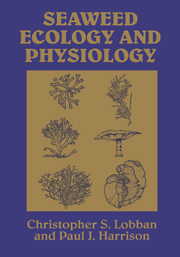Book contents
- Frontmatter
- Contents
- List of contributors
- Preface
- 1 Morphology, life histories, and morphogenesis
- 2 Seaweed communities
- 3 Biotic interactions
- 4 Light and photosynthesis
- 5 Nutrients
- 6 Temperature and salinity
- 7 Water motion
- 8 Pollution
- 9 Seaweed mariculture
- Appendix: Taxonomic classification of algae mentioned in the text
- References
- Index
4 - Light and photosynthesis
Published online by Cambridge University Press: 18 December 2009
- Frontmatter
- Contents
- List of contributors
- Preface
- 1 Morphology, life histories, and morphogenesis
- 2 Seaweed communities
- 3 Biotic interactions
- 4 Light and photosynthesis
- 5 Nutrients
- 6 Temperature and salinity
- 7 Water motion
- 8 Pollution
- 9 Seaweed mariculture
- Appendix: Taxonomic classification of algae mentioned in the text
- References
- Index
Summary
Seaweeds grow in circumstances that feature exceptionally diverse and dynamic lighting climates. The water clarity and the continual ebb and flood of tides have profound effects on the quantity and quality of the light that reaches seaweeds, adding greatly to the variation already present in the irradiance at the earth's surface. The primary importance of light to seaweeds is in providing the energy for photosynthesis, energy that ultimately is passed on to other organisms. Light also has many photoperiodic and photomorphogenetic effects, as we saw in Chapter 1. Thus light is the most important abiotic factor affecting plants, and also one of the most complex.
The principles of photosynthesis are similar in algae and higher plants, and indeed some principles (e.g., the Calvin cycle) were worked out using algae. Most of the catalytic proteins involved in the thylakoid reactions of red algae, for instance, are homologous with those in all other photosynthetic plants, but some are analogous (Raven et al. 1990). There are, moreover, several important features of seaweeds and their habitats that stand in sharp contrast to those in higher plants, the land plants, and it is on these that we shall focus. Such features include the diversity of pigmentation among marine algae and the diversity of the light climate in the oceans, the nature of the carbon supply in the sea, and the diversity of photosynthetic products in different algal classes.
- Type
- Chapter
- Information
- Seaweed Ecology and Physiology , pp. 123 - 162Publisher: Cambridge University PressPrint publication year: 1994
- 9
- Cited by



